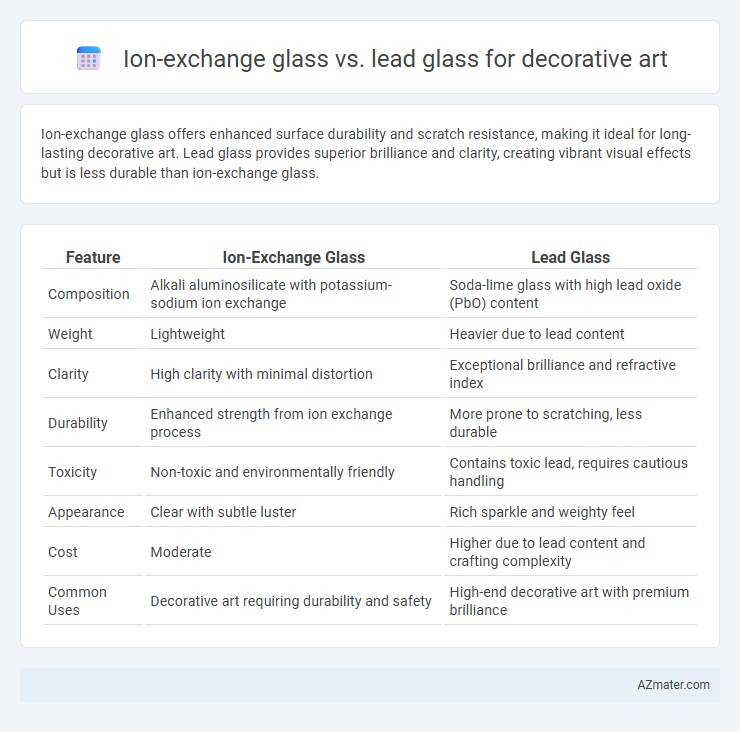Ion-exchange glass offers enhanced surface durability and scratch resistance, making it ideal for long-lasting decorative art. Lead glass provides superior brilliance and clarity, creating vibrant visual effects but is less durable than ion-exchange glass.
Table of Comparison
| Feature | Ion-Exchange Glass | Lead Glass |
|---|---|---|
| Composition | Alkali aluminosilicate with potassium-sodium ion exchange | Soda-lime glass with high lead oxide (PbO) content |
| Weight | Lightweight | Heavier due to lead content |
| Clarity | High clarity with minimal distortion | Exceptional brilliance and refractive index |
| Durability | Enhanced strength from ion exchange process | More prone to scratching, less durable |
| Toxicity | Non-toxic and environmentally friendly | Contains toxic lead, requires cautious handling |
| Appearance | Clear with subtle luster | Rich sparkle and weighty feel |
| Cost | Moderate | Higher due to lead content and crafting complexity |
| Common Uses | Decorative art requiring durability and safety | High-end decorative art with premium brilliance |
Introduction to Glass Types in Decorative Art
Ion-exchange glass offers enhanced surface strength and scratch resistance, making it ideal for durable decorative art pieces that maintain clarity and shine over time. Lead glass, known for its high refractive index and brilliance, provides exceptional light dispersion and a traditional aesthetic favored in ornamental art. Both glass types serve distinct artistic purposes, with ion-exchange glass emphasizing durability and lead glass focusing on visual sparkle and elegance.
What is Ion-Exchange Glass?
Ion-exchange glass is a type of strengthened glass created through a chemical process where smaller sodium ions on the glass surface are replaced by larger potassium ions, resulting in increased surface compression and improved durability. This method enhances resistance to scratches and breakage without compromising clarity, making it ideal for decorative art pieces requiring both beauty and resilience. Ion-exchange glass offers a safer alternative to lead glass, which contains harmful lead oxide but is traditionally valued for its brilliance and weight.
What is Lead Glass?
Lead glass, also known as lead crystal, contains lead oxide which increases its density and refractive index, giving it exceptional brilliance and clarity ideal for decorative art. This type of glass is prized for its heavy, sparkling appearance and ease of cutting or engraving, making it a favorite for intricate and luxurious designs. Unlike ion-exchange glass, lead glass offers a distinct aesthetic quality due to its high lead content but is less durable and heavier.
Optical Properties: Clarity and Brilliance
Ion-exchange glass exhibits superior clarity and brilliance compared to lead glass due to its enhanced surface hardness and reduced internal stress, resulting in minimal light scattering and higher optical purity. While lead glass is known for its high refractive index that produces intense sparkle and brilliance, it often suffers from cloudiness over time due to its susceptibility to environmental degradation. The ion-exchange process strengthens the glass surface, preserving vivid color transmission and sharp light refraction, making it an excellent choice for long-lasting decorative art with exceptional optical performance.
Strength and Durability Comparison
Ion-exchange glass offers superior strength and enhanced scratch resistance compared to lead glass, making it an excellent choice for decorative art requiring durability. The ion-exchange process strengthens the glass surface by replacing smaller sodium ions with larger potassium ions, resulting in increased resistance to mechanical stress and impact. Lead glass, while prized for its brilliance and clarity, tends to be softer and more prone to scratching and chipping, reducing its longevity in high-handling decorative applications.
Artistic Flexibility and Workability
Ion-exchange glass offers enhanced artistic flexibility due to its increased surface strength and resistance to scratches, allowing artists to create intricate details without compromising durability. Lead glass provides superior clarity and a high refractive index, making it ideal for vibrant color displays and light refractions, but it is softer and requires careful handling during shaping and etching. The choice between ion-exchange and lead glass depends on the desired balance between workability and optical brilliance in decorative art pieces.
Coloration and Surface Effects
Ion-exchange glass offers vibrant, consistent coloration achieved through surface-level ion replacement, producing enhanced durability and scratch resistance ideal for decorative art. Lead glass excels in depth and brilliance of color due to its high refractive index, creating rich surface effects with superior clarity and sparkle. Both materials provide distinctive aesthetic qualities, with ion-exchange glass favoring durability and vivid hues, while lead glass emphasizes luminosity and intricate light dispersion.
Safety and Environmental Considerations
Ion-exchange glass offers enhanced safety over lead glass in decorative art due to its increased strength and resistance to breakage, reducing the risk of injury from shattered pieces. Lead glass contains toxic lead oxide, posing significant environmental hazards during production, use, and disposal, whereas ion-exchange glass is free from heavy metals and more environmentally friendly. The non-toxic nature and recyclability of ion-exchange glass make it the safer and more sustainable choice for decorative applications.
Cost and Availability in Art Markets
Ion-exchange glass offers enhanced durability and scratch resistance compared to lead glass, making it a preferred choice for contemporary decorative art despite its higher production cost. Lead glass remains more affordable and widely available in traditional art markets due to established manufacturing processes and historical demand. Artists and collectors balance cost and accessibility, often favoring lead glass for classic aesthetics while exploring ion-exchange glass for modern, long-lasting pieces.
Choosing the Best Glass for Decorative Art Applications
Ion-exchange glass offers superior surface strength and scratch resistance, making it ideal for decorative art pieces requiring durability and longevity. Lead glass, known for its high refractive index and brilliance, provides exceptional clarity and sparkle that enhances visual appeal in decorative applications. Selecting between ion-exchange and lead glass depends on prioritizing either durability or optical brilliance to achieve the desired artistic effect.

Infographic: Ion-exchange glass vs Lead glass for Decorative art
 azmater.com
azmater.com